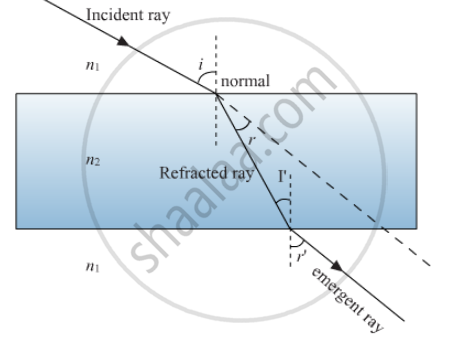Advertisements
Advertisements
Question
Draw a labelled ray diagram to show the angle of incidence and the angle of refraction for a refracted ray of light.
Solution
Diagram for a refracted ray of light:

Here,
i = Angle of incidence
r = Angle of refraction
i' = Angle of incident at the emergent point
r' = Angle of refraction at the emergent point
APPEARS IN
RELATED QUESTIONS
An object is placed at a distance of 15 cm from a concave lens of focal length 30 cm. List four characteristics (nature, position, etc.) of the image formed by the lens.
Where should an object be placed in front of a convex lens so as to obtain its virtual, erect and magnified image?
A convex lens of focal length 0.10 m is used to form a magnified image of an object of height 5 mm placed at a distance of 0.08 m from the lens. Calculate the position, nature and size of the image.
If the object is moved to a point only 3 cm away from the lens, what is the new position, height and nature of the image?
Complete the following sentence.
A long-sighted person cannot see ........... objects clearly. Long-sightedness can be corrected by using .............. lenses.
A pin 2 cm long is placed 12 cm away from a convex lens at right angles to the principal axis. If the focal length of the lens is 20 cm, by scale drawing find the size of the image and its magnification.
State the position of object, position of image, nature of image when: Convex lens is used as objective lens of photographic camera.
Why do we say that the ‘2F’ and ‘F’ points of a convex lens can be regarded as a sort of ‘turning points’ as far as the nature of the image formed by it is concerned?
Find the odd one out and give its explanation.
Write the name.
The lens used in simple microscope.
